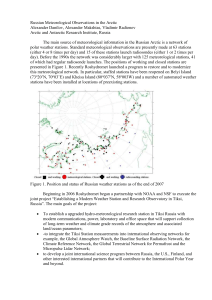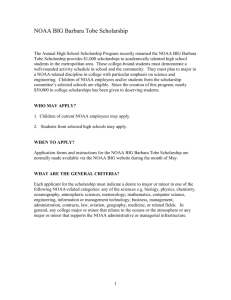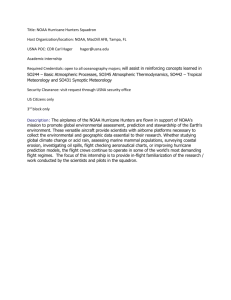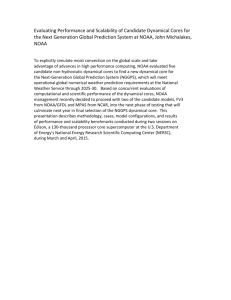NOAA approach to a new climatological observatory in
advertisement
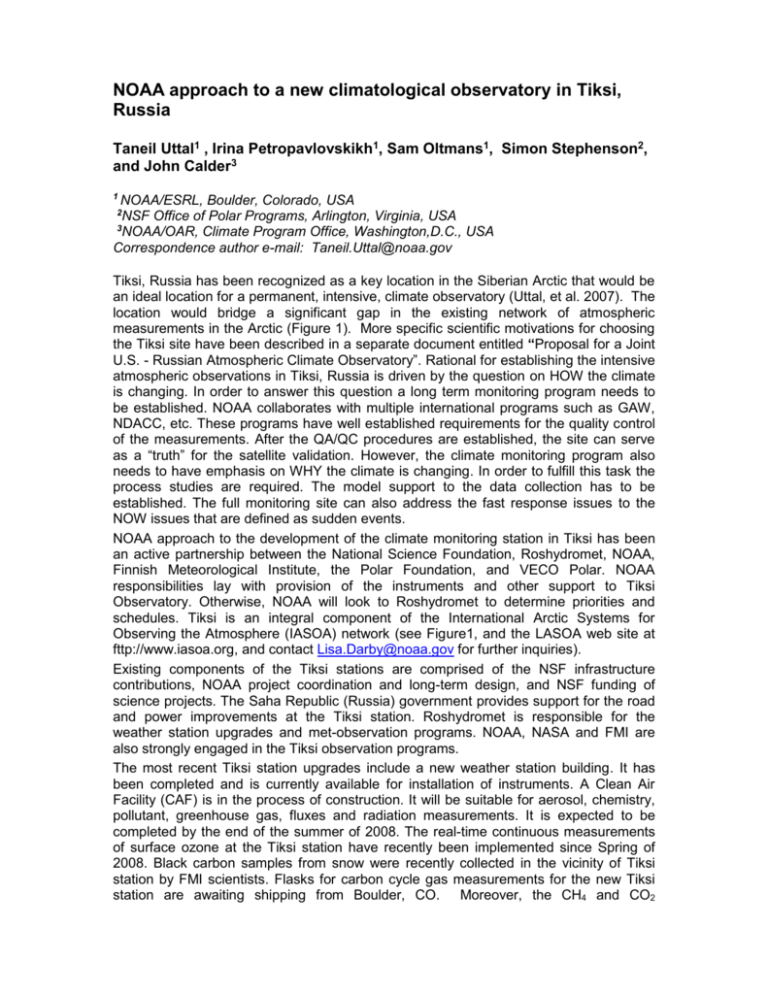
NOAA approach to a new climatological observatory in Tiksi, Russia Taneil Uttal1 , Irina Petropavlovskikh1, Sam Oltmans1, Simon Stephenson2, and John Calder3 1 NOAA/ESRL, Boulder, Colorado, USA NSF Office of Polar Programs, Arlington, Virginia, USA 3 NOAA/OAR, Climate Program Office, Washington,D.C., USA Correspondence author e-mail: Taneil.Uttal@noaa.gov 2 Tiksi, Russia has been recognized as a key location in the Siberian Arctic that would be an ideal location for a permanent, intensive, climate observatory (Uttal, et al. 2007). The location would bridge a significant gap in the existing network of atmospheric measurements in the Arctic (Figure 1). More specific scientific motivations for choosing the Tiksi site have been described in a separate document entitled “Proposal for a Joint U.S. - Russian Atmospheric Climate Observatory”. Rational for establishing the intensive atmospheric observations in Tiksi, Russia is driven by the question on HOW the climate is changing. In order to answer this question a long term monitoring program needs to be established. NOAA collaborates with multiple international programs such as GAW, NDACC, etc. These programs have well established requirements for the quality control of the measurements. After the QA/QC procedures are established, the site can serve as a “truth” for the satellite validation. However, the climate monitoring program also needs to have emphasis on WHY the climate is changing. In order to fulfill this task the process studies are required. The model support to the data collection has to be established. The full monitoring site can also address the fast response issues to the NOW issues that are defined as sudden events. NOAA approach to the development of the climate monitoring station in Tiksi has been an active partnership between the National Science Foundation, Roshydromet, NOAA, Finnish Meteorological Institute, the Polar Foundation, and VECO Polar. NOAA responsibilities lay with provision of the instruments and other support to Tiksi Observatory. Otherwise, NOAA will look to Roshydromet to determine priorities and schedules. Tiksi is an integral component of the International Arctic Systems for Observing the Atmosphere (IASOA) network (see Figure1, and the LASOA web site at fttp://www.iasoa.org, and contact Lisa.Darby@noaa.gov for further inquiries). Existing components of the Tiksi stations are comprised of the NSF infrastructure contributions, NOAA project coordination and long-term design, and NSF funding of science projects. The Saha Republic (Russia) government provides support for the road and power improvements at the Tiksi station. Roshydromet is responsible for the weather station upgrades and met-observation programs. NOAA, NASA and FMI are also strongly engaged in the Tiksi observation programs. The most recent Tiksi station upgrades include a new weather station building. It has been completed and is currently available for installation of instruments. A Clean Air Facility (CAF) is in the process of construction. It will be suitable for aerosol, chemistry, pollutant, greenhouse gas, fluxes and radiation measurements. It is expected to be completed by the end of the summer of 2008. The real-time continuous measurements of surface ozone at the Tiksi station have recently been implemented since Spring of 2008. Black carbon samples from snow were recently collected in the vicinity of Tiksi station by FMI scientists. Flasks for carbon cycle gas measurements for the new Tiksi station are awaiting shipping from Boulder, CO. Moreover, the CH4 and CO2 measurements, similar to those planned for Cherskii station in Russia, are in the planning stages for Tiksi. These upgrades are a result of a partnership between the U.S. National Science Foundation (NSF), the Russian Federal Service for Hydrometeorology and Environmental Monitoring (Roshydromet), the National Oceanic and Atmospheric Administration (NOAA) and the Finnish Meteorological Institute (FMI). In addition to the Tiksi station, Cherskii station in Russia is expected to undergo several upgrades. The University of Alaska Fairbanks (UAF) and the National Oceanic and Atmospheric Administration (NOAA) are collaborating on measurements of CO 2 and CH4 from 3 levels on a tower. The CH4 measurements will be combined with new modeling methods developed at NOAA to infer regional-scale CH4 fluxes. These estimates will complement CH4 fluxes determined by UAF using a flux gradient method. Installation of instruments is scheduled for summer 2008. This work is timely and important due to the large carbon stores, mostly CH4 that could be released in response to climate change. Current instrumentation planned for Tiksi stations includes Ozone meter (already installed in Tiksi, see Figure 2), black carbon sampler (ready to ship), USCRN (ready to ship with 2 months notice). In addition the carbon cycle gas sampler is planned for the station, but the issues with sample shipping have to be resolved before the installation. Black Carbon samples were collected in snow by FMI team that was on site in April, 2008. Atmospheric Radiation sensors are partially purchased, while Micrometeorology Flux sensors and aerosol sensors are not yet purchased. There is a possibility for the UV sensors to be purchased through the NSF contribution. The FMI contribution is in the supplies of the methane samplers. References Calder, J., 2004: Persistent Organic Pollutants in the Arctic: Are persistent organic pollutants a threat to Arctic marine mammals? Extracted from Arctic Pollution Issues: A State of the Arctic Environment Report (Arctic Monitoring and Assessment Report), available at NOAA Arctic Theme Page (http://www.arctic.noaa.gov/essay_calder.html). Uttal T. et al., 2006: “Implementation Plan for Weather Station Upgrade and Development of International Climate Observatory at Tiksi, Russia”, NOAA/ESRL Boulder, Colorado, USA, January 24, 2006. Stone B., et al., “Proposal for a Joint U.S. - Russian Atmospheric Climate Observatory”, 2005. Figure legends Figure 1. The schematic of the International Arctic Systems for Observing the Atmosphere (IASOA) network. Figure 2. Ozone surface detector (contact is S. Oltmans and NOAA/ESRL, Boulder, CO) and picture of the room in the hydrometeorology observatory building in Tiksi, Russia showing the installed and active Ozone Sampler instrument. Figure 1. The schematic of the International Arctic Systems for Observing the Atmosphere (IASOA) network. Figure 2. Ozone surface detector (contact is S. Oltmans and NOAA/ESRL, Boulder, CO) and picture of the room in the hydrometeorology observatory building in Tiksi, Russia showing the installed and active Ozone Sampler instrument.
